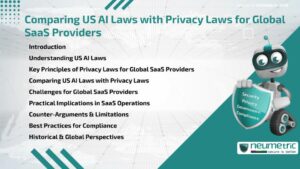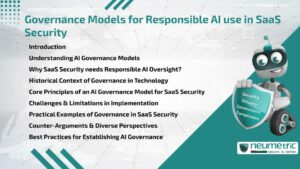Table of Contents
ToggleIntroduction
As Artificial Intelligence [AI] becomes deeply embedded in business & public systems, the demand for responsible & explainable algorithms continues to rise. Algorithmic transparency is central to ensuring AI Systems operate fairly, accountably & in alignment with human rights. The ISO 42001 requirements for algorithmic transparency serve as a structured response to this need, helping organisations develop Artificial Intelligence Management Systems [AIMS] that are both auditable & trustworthy.
This article explores what the ISO 42001 Standard entails, how it enhances algorithmic transparency & what organisations must do to comply.
Understanding ISO 42001 & Algorithmic Transparency
ISO 42001 is the first international Standard specifically designed to regulate the management of AI Systems. It provides a Framework that aligns AI Development & deployment with organisational Governance, ethical use & societal expectations.
Algorithmic transparency, in this context, refers to the ability to explain how AI Systems make decisions, including what data is used, what logic is applied & what outputs are generated. The ISO 42001 requirements for algorithmic transparency aim to create clarity & reduce opacity across these decision-making processes.
Key Principles Behind Transparency in AI Systems
Transparency in AI Systems is built on several foundational principles:
- Explainability: Systems should be able to provide understandable outputs to end users & regulators.
- Accountability: Stakeholders must take responsibility for how algorithms behave.
- Traceability: Every AI decision or action should be traceable back to its data input or logical rule.
- Non-discrimination: The system should be auditable to confirm fairness & avoid biased outcomes.
The ISO 42001 requirements for algorithmic transparency incorporate these principles by promoting clear documentation, internal controls & Governance protocols.
ISO 42001 Requirements for Algorithmic Transparency
At the heart of the standard, the ISO 42001 requirements for algorithmic transparency cover several operational & procedural expectations, including:
- Maintaining visibility into data sources & model training steps.
- Ensuring systems can generate explainable outputs.
- Creating a chain of accountability for AI-driven decisions.
- Implementing processes to document changes in algorithms over time.
- Making transparency a part of internal audits & Risk Assessments.
These requirements do not dictate how an AI must be built technically but focus on how it should be governed & disclosed within a responsible Framework.
A helpful external guide is this NIST publication on AI Risk Management, which aligns well with ISO 42001 goals.
Documentation & Disclosure Obligations
Documentation is one of the most essential elements of achieving transparency.Organisations are required to:
- Keep detailed records of AI Development pipelines.
- Keep records of model revisions & the versions of training data used.
- Publish summaries of AI decision-making logic, where possible.
Disclosure should be done in plain language so that Stakeholders — from users to auditors — can understand the scope, intent & limitations of AI Systems. The ISO 42001 requirements for algorithmic transparency ensure that technical operations are not hidden behind proprietary jargon.
Stakeholder Communication & Accountability
Transparent AI Systems must communicate with all relevant Stakeholders — internal teams, regulators & users. ISO 42001 encourages:
- Publishing algorithmic Policies in accessible language.
- Assigning roles & responsibilities across AI lifecycle stages.
- Building feedback mechanisms to address concerns.
This approach not only improves trust but also ensures that the ISO 42001 requirements for algorithmic transparency align with Stakeholder rights & expectations.
Auditability & Explainability Measures
Auditing AI Systems requires more than logging outputs. ISO 42001 requires organisations to:
- Enable Third Party assessments of model performance.
- Maintain a historical record of algorithm changes.
- Use tools that support explainability of predictions & outcomes.
These steps help organisations demonstrate that they meet the ISO 42001 requirements for algorithmic transparency in practice, not just on paper.
Limitations & Practical Challenges
While the Standard offers clear guidance, it’s important to acknowledge certain challenges:
- Legacy AI Systems may not support explainability features.
- Smaller organisations may lack the resources to fully implement documentation.
- Trade-offs may arise between transparency & IP protection.
Still, the ISO 42001 requirements for algorithmic transparency allow flexibility in how these obligations are fulfilled based on context, scale & Risk.
Comparing ISO 42001 With Other Standards
ISO 42001 complements existing AI Frameworks like:
- NIST AI RMF
- OECD AI Principles
- IEEE’s guidelines for Ethically Aligned Design
In contrast to these, ISO 42001 allows for formal certification & strengthens accountability within the organisation. It gives enterprises a way to demonstrate structured control over algorithmic decisions — a core benefit of the ISO 42001 requirements for algorithmic transparency.
Steps to Implement ISO 42001 Requirements Effectively
To put ISO 42001 into action, organisations should:
- Conduct a Gap Analysis on current AI Systems.
- Train teams on documentation & ethical development.
- Build cross-functional Governance committees.
- Establish Continuous Monitoring & update cycles.
- Prepare for audits & Stakeholder disclosures.
Starting early helps embed the ISO 42001 requirements for algorithmic transparency into the design process, rather than retrofitting controls post-deployment.
Takeaways
- ISO 42001 formalises Governance for AI Systems with transparency at its core.
- Documentation, explainability & Stakeholder accountability are mandatory.
- The Standard balances flexibility with structured Risk-based expectations.
- Adopting ISO 42001 enables organisations to build trust & achieve regulatory acceptance.
- Transparency is not just a checkbox — it’s a foundation for responsible AI.
FAQ
What is the goal of ISO 42001 in relation to algorithmic transparency?
The objective is to make AI systems explainable, well-documented & accountable by ensuring their decision-making processes are transparent & open to audit.
Does ISO 42001 require open-source AI Models?
No, it does not require open-source models. It mandates that organisations ensure clarity on how AI systems function & how their decisions are derived.
Who is accountable for upholding the algorithmic transparency as per ISO 42001?
Responsibility lies with defined Stakeholders across the AI lifecycle, including developers, auditors & Compliance officers.
What are the differences between ISO 42001 & the EU AI Act in terms of transparency?
While the EU AI Act mandates legal obligations, ISO 42001 provides a voluntary but certifiable Standard focused on organisational practices & transparency.
Can ISO 42001 help detect algorithmic bias?
Yes, through its transparency & auditability requirements, ISO 42001 can support efforts to identify & correct bias in AI Systems.
What are the challenges in meeting ISO 42001 requirements for algorithmic transparency?
Challenges include technical limitations in older AI Systems, lack of resources in smaller firms & managing proprietary trade-offs.
Are the ISO 42001 requirements for algorithmic transparency applicable to all types of AI systems?
Yes, though the depth & complexity of implementation may vary depending on the system’s purpose, Risk level & organisational size.
Is ISO 42001 mandatory for AI developers?
No, it is voluntary but widely recommended as a best-practice Standard for responsible AI Management.
Need help?
Neumetric provides organisations the necessary help to achieve their Cybersecurity, Compliance, Governance, Privacy, Certifications & Pentesting goals.
Organisations & Businesses, specifically those which provide SaaS & AI Solutions, usually need a Cybersecurity Partner for meeting & maintaining the ongoing Security & Privacy needs & requirements of their Clients & Customers.
SOC 2, ISO 27001, ISO 42001, NIST, HIPAA, HECVAT, EU GDPR are some of the Frameworks that are served by Fusion – a centralised, automated, AI-enabled SaaS Solution created & managed by Neumetric.
Reach out to us!





